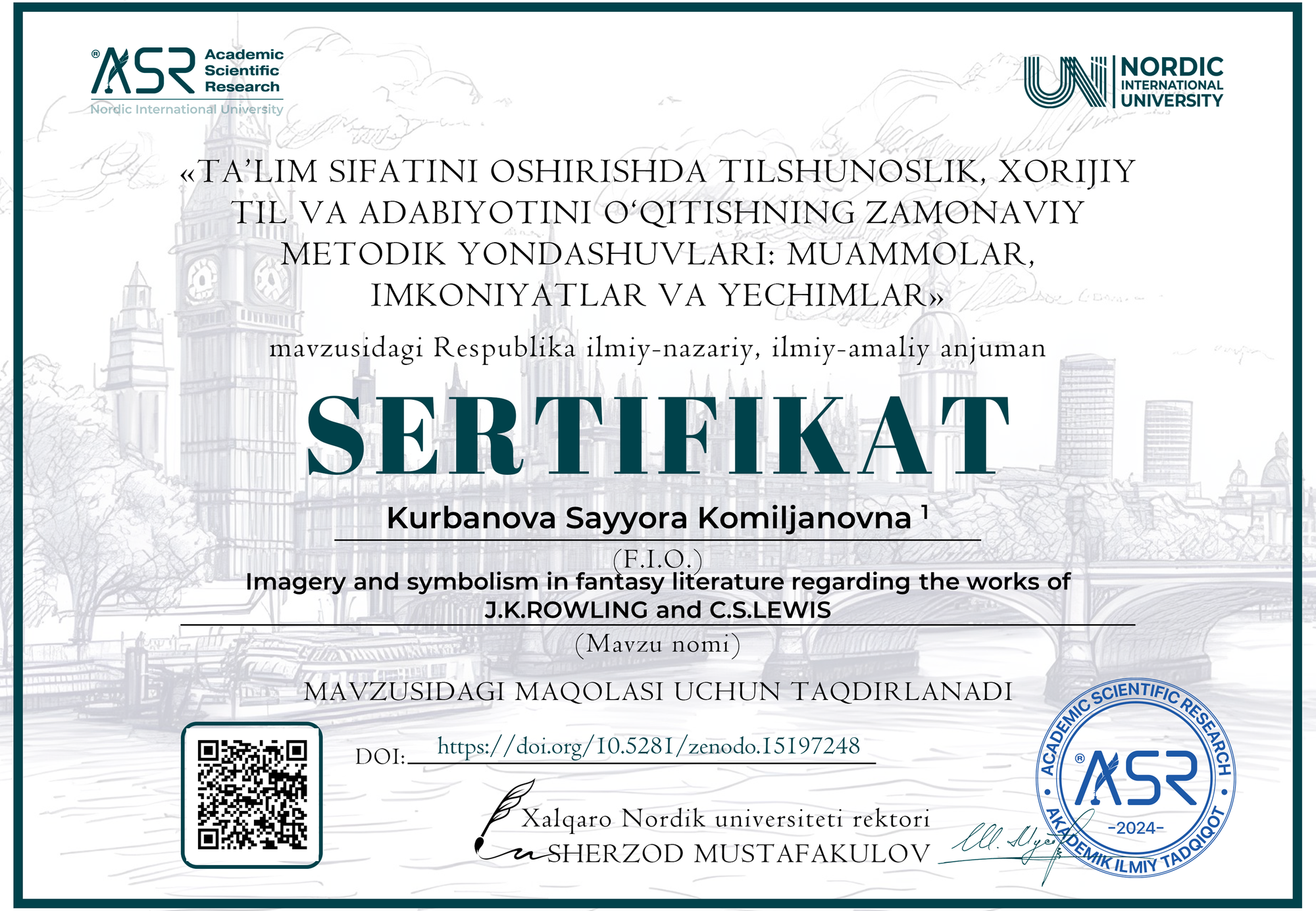Kurbanova Sayyora Komiljanovna 1

DOI: https://doi.org/10.5281/zenodo.15197248
Zenodo community: https://zenodo.org/records/15197248
Nordic_press journal: https://research.nordicuniversity.org/index.php/nordic/article/view/2341
MAQOLANI YUKLAB OLISH
SERTIFIKATNI YUKLAB OLISH
REVIEW:
Kurbanova Sayyora Komiljanovna’s article offers a thorough and insightful exploration of the imagery and symbolism in the works of two of the most influential authors in contemporary fantasy literature, J.K. Rowling and C.S. Lewis. Through a comparative approach, the article highlights the distinct narrative styles and thematic depth these authors bring to their respective fantasy worlds—Rowling with her modern, magical realms in the Harry Potter series, and Lewis with his allegorical landscapes in The Chronicles of Narnia.
The paper successfully argues that both authors use imagery and symbolism not merely as decorative elements but as central devices that shape their stories, deepen character development, and reinforce the thematic cores of their works. Rowling, known for her modern and accessible storytelling, weaves powerful symbols such as Harry’s lightning bolt scar and the Sorting Hat, which resonate deeply with themes of identity, personal choice, and self-discovery. These symbols, the author asserts, make Rowling’s world both relatable and emotionally engaging for readers of all ages, particularly younger audiences navigating their personal growth.
In contrast, C.S. Lewis takes a more classical and allegorical approach to symbolism. The article notes how Lewis infuses his narrative with rich Christian and mythological symbols—most notably, the character of Aslan, who represents sacrifice, redemption, and hope. The Chronicles of Narnia is framed not only as an adventurous fantasy but as a moral and philosophical narrative, inviting readers to reflect on faith, the battle between good and evil, and the transformative power of love. Lewis’s employment of expansive, mythic landscapes further enhances the timeless, almost sacred quality of his storytelling.
The analysis also delves into the stylistic differences between the two authors. While Rowling’s fantasy world combines magic with the mundane, thereby grounding the fantastical elements in a contemporary setting, Lewis’s Narnia is wholly immersed in allegory and religious symbolism, emphasizing the eternal struggle between good and evil. The comparative study highlights how both authors engage readers not only through their captivating narratives but also by challenging them to confront deeper existential questions about morality, identity, and human nature.
One of the article's strengths is its emphasis on how both authors’ works transcend mere escapism, offering a more profound exploration of the human condition. For instance, while Rowling’s Harry Potter series touches on contemporary issues such as social struggles and personal resilience, Lewis’s Narnia tackles universal spiritual and moral dilemmas, making both sets of works powerful in their own right.
The paper effectively supports its argument with detailed textual analysis and secondary literature, providing readers with a comprehensive understanding of the significance of imagery and symbolism in fantasy literature. The approach is both scholarly and accessible, drawing connections between the authors’ works and broader literary traditions, mythology, and religious symbolism.
Overall, Kurbanova's article offers a valuable contribution to the study of fantasy literature, presenting a nuanced and detailed comparison of two towering figures in the genre. By showcasing how Rowling and Lewis use imagery and symbolism to craft not only immersive worlds but also thought-provoking narratives, the article emphasizes the lasting impact of their works. The study underscores that fantasy literature, as exemplified by these authors, continues to resonate with readers by blending entertainment with philosophical reflection, ensuring the continued relevance of these classic texts across generations.
Key Strengths:
Comprehensive comparative analysis of two prominent authors.
Insightful exploration of symbolism and imagery in relation to character and thematic development.
Clear articulation of how both authors engage with universal themes such as good versus evil, personal growth, and spiritual redemption.
A blend of textual analysis and intertextual references to other works in the fantasy genre.
Suggestions for Improvement:
While the analysis is strong, further exploration of the cultural and historical contexts that influenced both authors' works could deepen the reader's understanding of their symbolic choices.
A more direct comparison of the ways in which specific symbols function within each narrative (e.g., the significance of the lightning bolt scar in Harry Potter vs. the role of Aslan in Narnia) would provide additional clarity.
In conclusion, this article is a well-researched, insightful piece that will appeal to scholars and enthusiasts of fantasy literature, offering a deeper understanding of the narrative techniques that have shaped the genre’s evolution and continue to influence modern storytelling.



